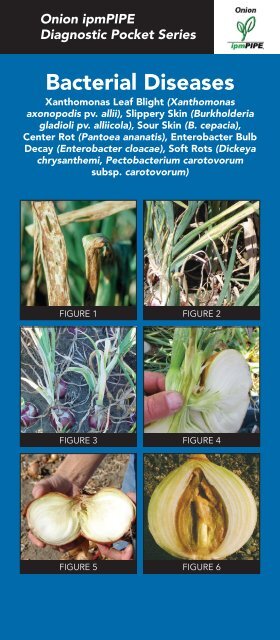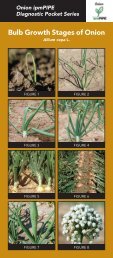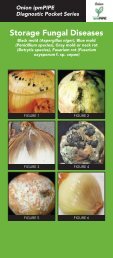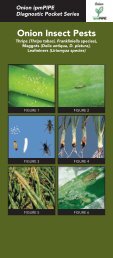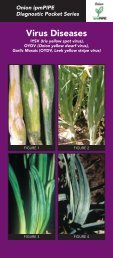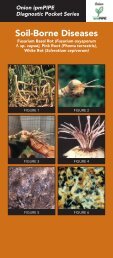Bacterial Diseases
Bacterial Diseases - Washington State University
Bacterial Diseases - Washington State University
- No tags were found...
You also want an ePaper? Increase the reach of your titles
YUMPU automatically turns print PDFs into web optimized ePapers that Google loves.
Onion ipmPIPE<br />
Diagnostic Pocket Series<br />
<strong>Bacterial</strong> <strong>Diseases</strong><br />
Xanthomonas Leaf Blight (Xanthomonas<br />
axonopodis pv. allii), Slippery Skin (Burkholderia<br />
gladioli pv. alliicola), Sour Skin (B. cepacia),<br />
Center Rot (Pantoea ananatis), Enterobacter Bulb<br />
Decay (Enterobacter cloacae), Soft Rots (Dickeya<br />
chrysanthemi, Pectobacterium carotovorum<br />
subsp. carotovorum)<br />
Figure 1 Figure 2<br />
Figure 3 Figure 4<br />
Figure 5 Figure 6
Onion ipmPIPE<br />
Diagnostic Pocket Series<br />
<strong>Bacterial</strong> <strong>Diseases</strong><br />
AUTHORS: B. K. Schroeder (Washington State University) and<br />
H. F. Schwartz (Colorado State University) PHOTOGRAPHS:<br />
Courtesy of H. F. Schwartz, L. J. du Toit and B. K. Schroeder<br />
[01/2011]<br />
Common Hosts: Onion, Garlic<br />
Symptoms (on Onion Leaves and Bulbs):<br />
Figure 1 • Xanthomonas leaf blight lesions appear as<br />
irregularly shaped, white flecks, pale spots, or lenticular lesions<br />
with water-soaked margins. Lesions enlarge, become tan to<br />
brown, cause extensive water-soaking, dieback and blighting of<br />
foliage, but not bulb infection.<br />
Figure 2 • In the field, early stages of bacterial leaf infection<br />
will appear as watersoaking along the entire length of the leaf;<br />
Figure 3 • later stages appear bleached (white to tan) and<br />
desiccated. No fungal structures will be present.<br />
Figure 4 • Soft rot may appear in the field or in storage<br />
as water-soaked tissue of leaves, neck and/or bulb; usually<br />
progressing from leaves to the neck to the bulb. The interior of<br />
the bulb may break down and a watery, foul-smelling liquid may<br />
ooze from the neck if the affected bulb is squeezed.<br />
Figure 5 • <strong>Bacterial</strong> bulb infection can be observed while<br />
plants are in the field or in storage. Softening of the neck may<br />
be observed and bulb tissue may appear translucent or watersoaked.<br />
Figure 6 • Enterobacter bulb decay appears firm and healthy<br />
until cut to expose interior scales which are brown, soft and<br />
rotten; progressing downward from the neck.<br />
Factors Favoring:<br />
Most bacteria are favored by:<br />
• Harvest and storage temperatures above 30°C (86°F); some<br />
are favored by lower temperatures.<br />
• Free moisture and high humidity (greater than 75%) during<br />
production and harvest.<br />
• Planting of contaminated seed, transplants, sets<br />
• Irrigation water; storm damage; excess nitrogen after bulb<br />
initiation; insects like thrips and maggots; and bruising<br />
during harvest.<br />
Sponsored in part by:<br />
ADDITIONAL RESOURCES AVAILABLE AT:<br />
http://onion.ipmpipe.org<br />
http://wiki.bugwood.org/PIPE:Onion<br />
http://www.apsnet.org/ — Compendium of Onion & Garlic<br />
<strong>Diseases</strong> and Pests, 2nd Ed.


